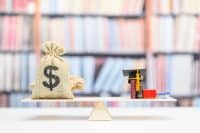
According to recent surveys and studies, it’s generally accepted that many Americans need at least $1 million to retire comfortably. That’s a large number, and one that can certainly seem daunting at first glance.
Of course, generating a portfolio of $1 million isn’t necessarily as hard as it was in years past. Wages have increased (though not to the same extent as assets) in recent decades, so many investors who have owned their principal residence, 401K retirement plans or other assets are likely sitting on some equity somewhere within their overall portfolios.
The question many who may be in the six-figure investment realm continue to ask is how to get their portfolio into the million-dollar range, and how to do so within the prescribed timeframes they’d like, in order to consider retirement. That’s a valid question, and it’s one that is worth diving into.
Of course, each individual investor’s path will be different. Compounding can work in an investor’s benefit, but the amount of time one has to realize returns over a long enough time frame will determine a great deal of the ultimate outcome – time can be an investor’s best friend, or worst enemy.
That said, there are some timeless principals all investors can live by, no matter what their current age or income is. Here are three strategies I think are worth considering – strategies I’m currently working to put in place in my own investing journey.
Key Points About This Article:
- Everyone’s retirement journey is different, but creating a million-dollar retirement portfolio is within reach for most investors.
- Here are three strategies every investor can take advantage of to realize the kind of dream retirement they’re after.
- If you’re looking for some stocks with huge potential, make sure to grab a free copy of our brand-new “The Next NVIDIA” report. It features a software stock we’re confident has 10X potential.
Start Saving Early

Every marathon begins with the first step, and it’s really the same in the world of investing. The sooner one gets started, the sooner compounding can work in one’s favor. And it’s generally well-known among many that putting $1,000 away when you’re 25 can have a much greater impact on your future savings goals that putting that same sum away when you’re 50.
Of course, for those who are much closer to retirement age than they are young adulthood, a lack of time can be a stressful reality that can hinder the small steps forward that are part and parcel of seeing compounding growth. Starting somewhere is often the hardest part, but it really is never too late to get started.
Forced savings, either via making consistent mortgage payments or contributing as much as possible to one’s 401(k) or Roth IRA over time is a great place to start. If it’s possible to live on less, maxing out one’s retirement accounts can pay big dividends in retirement. And the good news is that the IRS does allow for catch-up contributions for those over the age of 50, making it easier for those without the head start to get closer to their dream retirement.
Those who save roughly $190 per month from age 20 can achieve a $1 million retirement by the age of 65. This number goes up to $300 per month by age 25, $700 per month by age 35, and so on. But with age comes increased earning potential (typically), so at any stage of one’s life, the most important thing anyone can do is simply get started.
Diversify Your Portfolio

For those who are consistently putting money away in one form or another, that’s the first step. The next is to create a diversified portfolio of assets that can weather all economic environments.
The vast majority of Americans have most of their net worth locked into their principal residence (their home). That’s great, but it’s also generally true that the capital gains and dividends stocks provide can amplify one’s savings over the long-haul, and can provide the sort of million-dollar nest egg many are after much faster.
Investing in passive index funds is a great way to get involved in the market, and avoid excess volatility (over and above market volatility). Picking stocks is great, and investors should do so, if they’re able to balance sector-specific risks and create portfolios with as close to a zero beta as possible. For those not willing to put in the effort, most financial experts continue to argue for investing in a market-specific index fund such as SPY or VTI. I can’t disagree with such an approach, at least for most investors.
Personally, my approach to the diversification topic is to own target-date funds, with additional sector-specific ETFs and a handful of single stocks to add amplified exposure to certain areas of the market. But to each their own. The idea is to have multiple asset classes working for you in retirement, with at least some funds held in liquid accounts (outside of real estate equity) to be tapped when the time comes.
Be Consistent

Consistency is always key to many facets of life. Indeed, investing is no different.
Putting away lump sums (such as tax returns or inheritances) is great. But finding a way to automate one’s savings into accounts that aren’t easily accessible is really what many investors ascribe to lead to the best outcomes over long periods of time.
Inevitably, life will happen. A big unexpected expense will come up. This means that investor who have set aside an emergency fund (generally advised to be between six and 12 months of expenses) can weather such expenses without having to tap the retirement accounts. The more money that can continue to accumulate in these accounts consistently over long periods of time, the better.
Seeing consistent returns over time (barring economic downturns) can also be motivating for many individuals. And while it’s generally good advice to not check the retirement account every day, those who are able to contribute on a more consistent basis often get a rush from seeing the specific number rise over time. Even in downturns, those who continue to contribute can see progress over shorter term time frames. Thus, continuing to pile money into a retirement account in any market environment is generally the way to go, if one can slice it.
It’s Your Money, Your Future—Own It (sponsor)
Retirement can be daunting, but it doesn’t need to be.
Imagine having an expert in your corner to help you with your financial goals. Someone to help you determine if you’re ahead, behind, or right on track. With SmartAsset, that’s not just a dream—it’s reality. This free tool connects you with pre-screened financial advisors who work in your best interests. It’s quick, it’s easy, so take the leap today and start planning smarter!
Don’t waste another minute; get started right here and help your retirement dreams become a retirement reality.
Thank you for reading! Have some feedback for us?
Contact the 24/7 Wall St. editorial team.




